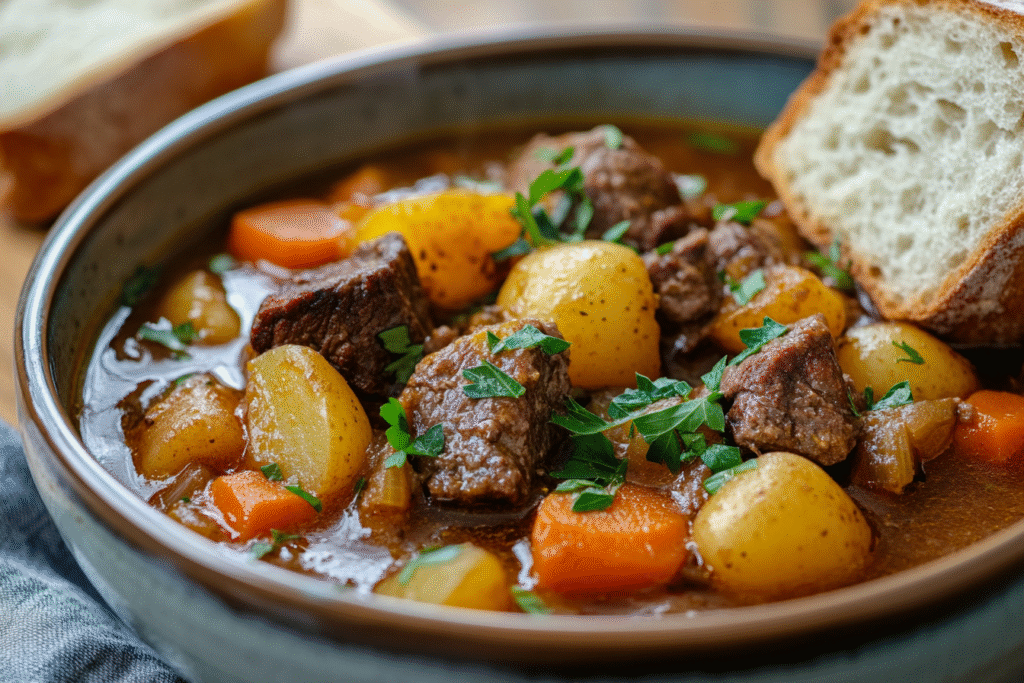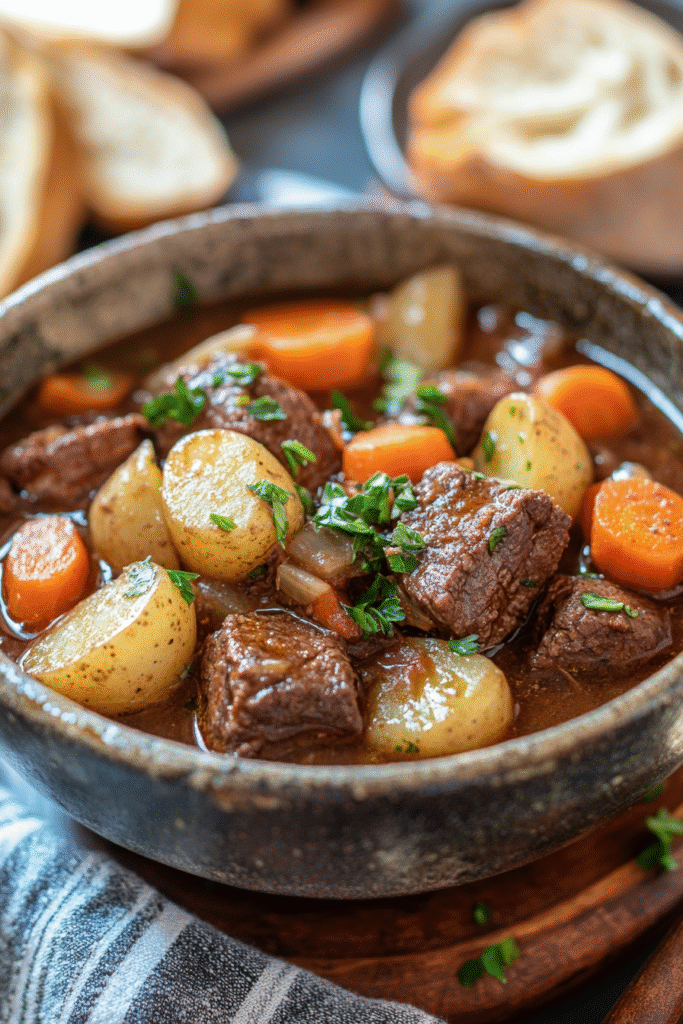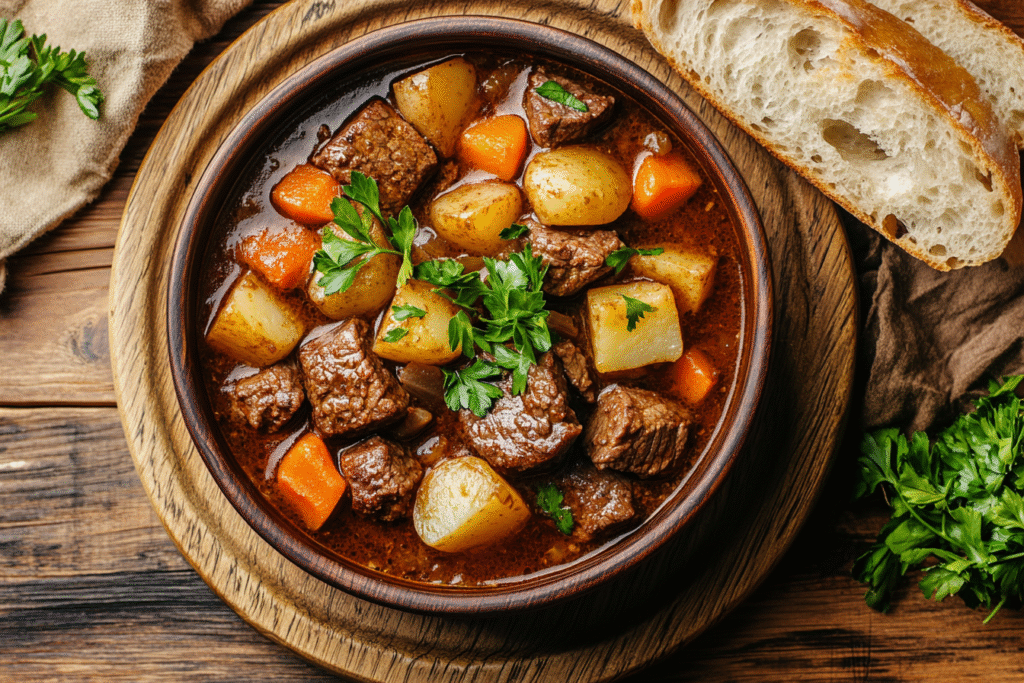Beef stew is the ultimate comfort food—rich, savory, and soul-warming, especially on a chilly day. There’s something magical about tender chunks of beef, soft potatoes, sweet carrots, and a deeply flavorful broth slowly melding together in one pot. It’s rustic, satisfying, and, when made correctly, absolutely unforgettable.
In this Classic Beef Stew Recipe, we’ll explore everything you need to know to create a stew that’s perfectly balanced: beef that melts in your mouth, vegetables that hold their texture, and a broth that’s thick, velvety, and packed with flavor. Whether you’re new to stewing or looking to elevate your technique, this guide is for you.
Why Beef Stew Can Be Tricky: Common Mistakes and How to Avoid Them
Beef stew may seem simple, but several pitfalls can result in less-than-ideal outcomes:
- Tough beef that’s chewy instead of tender.
- Watery broth that lacks richness.
- Mushy vegetables that have lost their structure.
- Bland flavor from underdeveloped seasoning or rushed cooking.
The solution? Time and technique.
Beef stew relies on low and slow cooking to break down the connective tissues in tougher cuts of meat, transforming them into fork-tender perfection. Rushing this process will almost always lead to tough beef.
The broth must reduce and concentrate over time to develop that deep, savory flavor we all crave. Skipping the browning step or failing to layer seasonings properly can result in a stew that tastes flat.
This recipe carefully addresses these challenges with step-by-step instructions that ensure a successful outcome.

Choosing the Best Ingredients for Beef Stew
Beef Selection
Not all beef is created equal when it comes to stewing. Look for cuts with connective tissue and marbling, which break down beautifully with slow cooking.
- Chuck Roast: The gold standard for beef stew. Affordable, well-marbled, and incredibly flavorful when braised.
- Brisket or Round: Can be used but may result in slightly leaner, less tender meat.
- Pre-cut Stew Meat: Convenient but often a mix of cuts—can be inconsistent in texture. Buy whole chuck and cube it yourself for best results.
Vegetables
- Potatoes: Waxy varieties like Yukon Gold hold their shape better than starchy potatoes like Russets, which tend to disintegrate.
- Carrots: Add natural sweetness and color.
- Onions and Garlic: Build aromatic depth.
- Celery: Optional but traditional for extra flavor.
Flavoring Ingredients
- Beef broth: Provides a rich base.
- Tomato paste: Adds umami and body to the broth.
- Red wine: Optional but highly recommended for deep flavor.
- Fresh herbs: Thyme, bay leaves, and parsley give the stew layers of aroma.
Essential Equipment for Beef Stew Success
- Large Dutch oven or heavy-bottomed pot: Crucial for even heat distribution and long, slow cooking.
- Wooden spoon or spatula: For scraping browned bits from the pan (which add tons of flavor).
- Sharp chef’s knife: For cubing the beef and chopping vegetables.
If you have a slow cooker or pressure cooker, this recipe can be adapted—I’ll cover those options later.

Preparation Strategies and Time-Saving Tips
Beef stew traditionally takes several hours, but there are ways to make the process efficient:
- Prep ingredients in advance: Cube the beef, chop vegetables, and measure out spices the day before.
- Use store-bought broth: Homemade is wonderful, but a good-quality store-bought broth works perfectly in this recipe.
- Batch cooking: Make a double batch and freeze leftovers for future meals.
Pro Tip: Always let the beef come to room temperature for about 15-20 minutes before searing to ensure even browning.
Flavor Enhancers and Customizations
- Wine: Adds depth and complexity; substitute with additional broth if preferred.
- Mushrooms: Introduce an earthy element.
- Pearl onions: Offer subtle sweetness.
- Worcestershire sauce or soy sauce: Add umami to the broth.
- Paprika or bay leaves: Enhance aroma.
Optional swaps:
- Gluten-free: Skip flour or use a gluten-free thickener.
- Low-carb: Omit potatoes and add more carrots or celery.
You can also finish the stew with a squeeze of lemon juice or a splash of balsamic vinegar to brighten the flavor.

Troubleshooting Common Stew Problems
- Beef is tough: It hasn’t cooked long enough. Even if it seems done, undercooked collagen can make beef chewy. Give it more time.
- Stew is thin: Simmer uncovered near the end to reduce the broth, or add a cornstarch slurry.
- Vegetables are mushy: Add them in stages. Potatoes and carrots only need the last 30-40 minutes of cooking.
- Bland flavor: Taste and adjust seasoning, especially salt, near the end. Add Worcestershire sauce or a splash of soy sauce for a flavor boost.
Storage, Freezing, and Reheating Tips
- Storage: Beef stew tastes even better the next day. Store in an airtight container in the fridge for up to 4 days.
- Freezing: Freeze in individual portions for up to 3 months. Thaw overnight in the fridge before reheating.
- Reheating: Gently reheat on the stovetop over medium heat or in the microwave in short intervals, stirring in between.
Stew thickens as it sits. You may need to add a splash of broth or water when reheating.
Classic Beef Stew Recipe
Ingredients
For the Stew:
- 2 pounds chuck roast, cut into 1½-inch cubes
- 3 tablespoons all-purpose flour
- 2 tablespoons olive oil
- 1 large onion, chopped
- 4 cloves garlic, minced
- 2 tablespoons tomato paste
- 1 cup red wine (optional, can substitute with more broth)
- 4 cups beef broth
- 1 teaspoon salt (adjust to taste)
- ½ teaspoon black pepper
- 1 teaspoon dried thyme or 3 sprigs fresh thyme
- 2 bay leaves
- 4 large carrots, cut into thick rounds
- 4 medium Yukon Gold potatoes, cut into chunks
- 2 stalks celery, sliced (optional)
- 1 tablespoon Worcestershire sauce (optional)
- Fresh parsley, chopped (for garnish)
Step-by-Step Instructions
Step 1: Prep and Brown the Beef
- Pat the beef dry with paper towels.
- Toss the beef cubes with flour, salt, and pepper until lightly coated.
- Heat olive oil in a large Dutch oven over medium-high heat.
- Sear the beef in batches for 3-4 minutes per side until browned. Remove and set aside.
Step 2: Build the Flavor Base
- In the same pot, add chopped onions and sauté for 5 minutes until softened.
- Stir in garlic and tomato paste, cooking for 1 minute until fragrant.
- Pour in red wine (if using) and scrape the bottom of the pot to deglaze, loosening the flavorful browned bits.
- Simmer for 2-3 minutes until the wine reduces slightly.
Step 3: Simmer the Stew
- Return the beef to the pot.
- Add beef broth, thyme, bay leaves, Worcestershire sauce (if using), and a pinch more salt and pepper.
- Bring to a simmer, cover, and reduce heat to low.
- Simmer for 1½ to 2 hours, stirring occasionally, until the beef is tender.
Step 4: Add Vegetables
- After 1½ hours, add carrots, potatoes, and celery.
- Continue simmering, covered, for another 30-40 minutes until vegetables are tender.
Step 5: Adjust and Serve
- Remove bay leaves and thyme sprigs.
- Taste and adjust seasoning with additional salt, pepper, or a splash of vinegar or lemon juice to brighten.
- Garnish with fresh parsley and serve hot.
Serving Suggestions
- Classic pairing: Serve with crusty bread or buttery biscuits to soak up the rich broth.
- Over starches: Ladle over mashed potatoes, buttered noodles, or rice for a heartier meal.
- With greens: Serve alongside a crisp green salad for balance.
Beef Stew Variations: Classic vs. Slow Cooker vs. Instant Pot
| Feature | Classic Stove-Top | Slow Cooker | Instant Pot |
|---|---|---|---|
| Cook Time | ~2½ hours | 7-8 hours (low) | ~1 hour (total) |
| Hands-On Time | Moderate | Minimal | Short |
| Texture | Traditional | Very tender | Slightly softer beef |
| Best For | Classic results | Set-it-and-forget-it | Quick preparation |
FAQs and Troubleshooting
Can I make this in a slow cooker?
Yes. Sear the beef and sauté the onions as directed, then transfer everything to a slow cooker. Cook on low for 7-8 hours or high for 4-5 hours.
How can I thicken the stew?
Let it simmer uncovered to reduce, or add a cornstarch slurry (1 tablespoon cornstarch mixed with 1 tablespoon cold water) and simmer until thickened.
Why is my beef not tender?
It likely hasn’t cooked long enough. Tough cuts need time for the connective tissues to break down.
Can I freeze beef stew?
Yes. Let it cool completely, portion into freezer-safe containers, and freeze for up to 3 months.
What herbs can I use?
Thyme, bay leaves, rosemary, and parsley all work well in beef stew.
Final Thoughts
This Classic Beef Stew Recipe is more than just a meal—it’s a bowl of pure comfort. With deep, layered flavors, tender beef, and hearty vegetables, it’s the kind of dish that brings people together around the table.
While it takes time to achieve stew perfection, the steps are straightforward, and the results are well worth it. Plus, it’s a fantastic make-ahead option that tastes even better the next day. Whether you follow the traditional stovetop method, opt for the convenience of a slow cooker, or use the speed of an Instant Pot, this beef stew will quickly become a cozy, satisfying favorite in your home.
